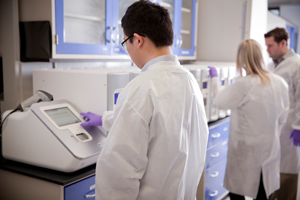Diarrhea caused by bacterial, viral, and/or parasitic infection represents a significant worldwide healthcare burden. Each year, there are two billion instances of diarrheal disease globally, resulting in nearly two million deaths.1 The World Health Organization estimates that diarrhea is the cause of or is a major contributor to approximately one-quarter of all post-neonatal childhood deaths.2 In the United States, an estimated 1.4 episodes of acute diarrhea occur per person each year.3 Though most cases of diarrheal disease are generally self-resolving and not life-threatening in immunocompetent individuals, certain bacterial and viral infections can result in serious clinical morbidity and even death.
From afar, diarrheal infection can be classified into two categories based on the source of infection: healthcare-acquired diarrhea and community-acquired diarrhea. Healthcare-acquired diarrhea is a diarrheal infection acquired within the hospital or in connection with receiving medical care. Clostridium difficile is typically the cause of these infections, which are a major healthcare concern. Community-acquired diarrhea, on the other hand, are those infections caused by environmental enteric bacteria, viruses, or parasites. These infections can be caused by a number of different sources including contaminated food and water sources, and are typically milder in presentation than healthcare-acquired diarrhea.
Community-acquired diarrhea affects millions alone each year in the United States alone, second only to respiratory illness for prevalence and stated reason for physician visit. These infections are typically transmitted by contaminated food or water sources, but can also be transmitted person-to-person, as in the case of Norovirus. Typically, in healthy adults, these infections are self-limiting and do not require antimicrobials to clear the infection. Community-acquired diarrhea can, however, have greater clinical implications in the very young, the elderly, and the immunocompromised. Symptoms associated with these infections range from asymptomatic to mild symptoms including watery diarrhea with nausea to the most severe symptoms which include diarrhea and nausea accompanied with fever/chills, abdominal cramps, hypotension, and in the case of shiga-toxin producing E. coli (STEC), the potentially fatal condition hemolytic uremic syndrome (HUS).
The current diagnostic challenge associated with detection of community-acquired diarrhea is twofold. Since clinical presentation of diarrheal disease does not narrow down the potentially responsible pathogen(s), physicians often end up taking the “shotgun” approach to diagnostic testing by ordering testing for a majority of stool pathogens. If physicians are able to characterize the patient’s history, it could greatly narrow the number of diagnostic tests necessary for a given patient. On the diagnostic end, stool culture and ova and parasite (O&P) remain the gold standard diagnostics. Though generally considered sensitive and specific, these procedures are labor-intensive, unpleasant for technicians, can take as long as 5-7 days to produce definitive results in the case of stool cultures, and require a high degree of technical skill in the case of performing O&Ps. Together, the excessive ordering of stool pathogen testing by physicians paired with less-than-ideal diagnostic options has led to what some consider significant inefficiencies in the clinical laboratory. As a result, medical technologists can spend unnecessary time working up negative stools, which can account for upwards of 95% of stools samples submitted for testing. Confirmation of a negative stool sample takes as few as 1-2 hours with a rapid diagnostic test, allowing laboratories to reallocate medical technologist time to other priorities.
Since treatment decisions can vary depending on the identity of the infectious agent and the overall health of the patient, rapid identification of pathogenic bacteria, viruses, and parasites from a stool specimen is crucial. From a therapeutic standpoint, rapid testing for stool pathogens can improve patient management decisions and minimize the use of inappropriate or unnecessary antimicrobials. This is especially important when it comes to detection of STEC, where continued antimicrobial exposure may increase the risk of a patient developing HUS.4 From a public health standpoint, rapid diagnostics for stool pathogens can trigger outbreak investigations earlier for such pathogens as Salmonella and Vibrio. Rapid identification of contagious stool pathogens like Norovirus and Shigella can allow for the proper infection control measures to be taken within a hospital or outside of a hospital at such places as long-term care or daycare facilities to minimize the spread of infection. Rapid diagnostic results can also mitigate further downstream testing, such as colonoscopies, when the origin of diarrheal infection is yet to be determined due to the slow turnaround time of conventional diagnostic methods.
Rapid diagnostics for stool pathogens have only recently emerged as viable options for testing for community-acquired diarrhea. Antibody-mediated EIA methods have shown the ability to shorten turnaround times for such stool pathogens as shiga-toxin producing E. coli (STEC), however, these kits lack the multiplexing capabilities necessary to replace culture for routine screening and may still require 12-24 hour turnaround times. Multiplex molecular methods are very well suited as the diagnostic platform for stool pathogens as these tests can target a majority of stool pathogens at one time. The sample-to-results automation and rapid turnaround times of these tests will result in improved workflow efficiencies in the clinical laboratory. The improved sensitivity of molecular-based tests over culture will also provide the accurate results necessary for earlier optimization of patient management, better infection control, and quicker public health response to potential outbreaks.
Diarrheal illness will continue to be a burden to healthcare providers worldwide. Rapid diagnostic tests for stool pathogens may provide a means to minimize the impact of this burden throughout the entire hospital.
Speakers

Amanda T. Harrington, Ph.D., D(ABMM) , Director, Clinical Microbiology Service, Assistant Professor, Pathology, University of Illinois at ChicagoJose Alexander, M.D., D(ABMM), SM, MB(ASCP), Microbiology Supervisor, Marin General Hospital, Greenbrae, California
Dr. Harrington is currently the Director of the Clinical Microbiology Laboratory for the University of Illinois Hospital and Health Sciences System (UIH) in Chicago, Illinois. Dr. Harrington received her Ph.D. in Microbiology from the University of Kansas in 2005 and completed a postdoctoral training program in Medical and Public Health Laboratory Microbiology at the University of Washington. Dr. Harrington’s research interests include bacterial strain typing and molecular epidemiology, rapid diagnostic and molecular-based testing in clinical microbiology and infectious diseases, and metrics based assessment of quality in clinical microbiology.

Jose Alexander, M.D., D(ABMM), SM, MB(ASCP) , Microbiology Supervisor, Marin General Hospital, Greenbrae, California
Dr. Alexander graduated as a physician in Venezuela with post training in Medical and Public Health Microbiology. Dr. Alexander’s work has been specialized in antimicrobial susceptibility testing, detection of antimicrobial resistance through phenotypical and molecular tests and Antimicrobial Stewardship Programs. Currently, Mr. Alexander is coordinating and directing the Microbiology Department at the Marin General Hospital integrating rapid molecular tests and multiplex panels.
Who Should Attend?
- Clinical/Reference Laboratory (PhD Microbiologist, Microbiology Supervisor, Clinical Laboratory Director, Medical Technologists, Outreach Coordinators)
- Infectious Disease Physicians
- Clinical Pharmacy (Antimicrobial Stewardship Team, ID Pharmacist)
- Physicians (Private Physicians, Hospitalists, Critical Care)
Xtalks Partner
Nanosphere
Nanosphere is dedicated to enhancing medicine by providing targeted and flexible molecular diagnostic tests that can lead to earlier disease detection, optimal patient treatment and improved healthcare economics. Our platform, the Verigene® System, enables clinicians to rapidly identify the bacteria and viruses responsible for some of the most complex, costly and deadly infectious diseases. Currently, the Verigene test menu targets infections of the bloodstream, respiratory tract and gastrointestinal tract.
You Must Login To Register for this Free Webinar
Already have an account? LOGIN HERE. If you don’t have an account you need to create a free account.
Create Account




